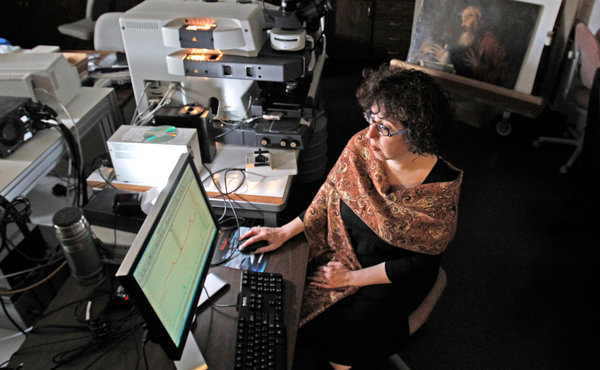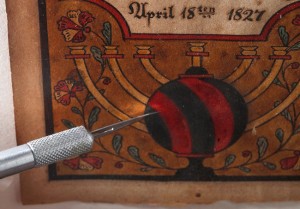How To Avoid Forgeries When Buying Fine Art

Jennifer Mass, of the Winterthur Museum, conducting forensic analysis on a painting attributed to Matthias Stom. Tim Shaffer for The New York Times
TALES about art forgeries are almost always intriguing. Maybe that’s because of the big amounts paid by unwitting buyers. Or that the people involved invariably emerge as characters worthy of a thriller.
The latest tale is no exception. It involves the Knoedler Gallery, the oldest art gallery in New York, which just closed under the weight of accusations that it had sold forged paintings by modern luminaries like Jackson Pollock, Robert Motherwell and Willem de Kooning. In retrospect, the details of the sales seemed suspect from the start — a little-known dealer selling formerly unknown modern masterpieces on behalf of an owner who requested anonymity to a gallery with major connections.
I know enough about the art world to know that is a secretive, clubby place with more than its fair share of eccentrics. Still, how does something like this happen and what recourse is there for the owners of forged art?

An illuminated section of a painting is tested for authenticity at the Winterthur Museum in Delaware. Tim Shaffer for The New York Times
Any serious collectors should know intuitively what to check before buying a piece of art.
They need to start by reviewing the painting’s history of ownership, known as the provenance. This is particularly important for older works because it allows the buyer to confirm what the seller is claiming, said Katja Zigerlig, vice president of fine arts, wine and jewelry insurance at Chartis Private Client Group.
They also need to search the Art Loss Register, an international database of stolen art, to make sure the piece has not been reported missing, and consult with the artist’s foundation, if one exists, to check if it has authenticated the piece.
(This last part has become more difficult in recent years. Raymond Dowd, a partner at the law firm Dunnington, Bartholow & Miller, said recent court rulings had said foundations were not bound to give an opinion either way. This stemmed from a series of lawsuits against foundations, most famously against the Warhol Foundation that asserted it had rejected authentic works to drive up the values of other Warhol pieces.)
Why collectors do not run through this checklist is no different from why hunters miss their shot at a glorious buck: they are so amazed by what they are seeing that they rush the process. While a hunter’s shot just whizzes by, a collector could end up handing over millions of dollars for something that is worthless — or that might cost hundreds of thousands of dollars more to prove that it is the real thing.
Ms. Zigerlig said she received a call in 2009 from a client who wanted to buy a Picasso in a private sale. His concern was getting insurance in place as soon as possible so nothing could derail the deal. She tried to slow him down. “I would ask, ‘have you checked provenance, have you gone through the art loss registry, have you asked if this has been authenticated?’ ” she said. “We stressed best practices.”
Recently, the ability to do crimelike forensic tests has caught on as a way to check that the art was produced when someone says it was. In the Knoedler case, forensic analysis on one of the so-called Pollock paintings showed that two of the yellow paints were invented after he died.
But even people who conduct these tests warn that they are only one part of the process. “It concerns me that people think science is the only factor,” said Jennifer L. Mass, senior scientist at the Winterthur Museum in Delaware. “We say it’s one part of it. We look to add to attribution.”
This technology is at its best in showing that something is a fake. “It will almost never prove that a work is authentic,” said Sharon Flescher, executive director of the International Foundation for Art Research, an educational and research organization that investigates claims of authenticity. “It can prove that a work is inauthentic, but not necessarily. If the materials are of the same period, you won’t find anachronisms.”
In other words, the materials were around when the artist worked, but there is not enough data on most artists to know what materials they worked with.
Of course, collectors who buy a fake piece of art are embarrassed. But no amount of shame compares with losing the money they spent on it. Insurance policies do not cover that loss.
“The supposition is we, the insurance world, are making a decision if something is real or a forgery,” Dorit Straus, worldwide fine art manager at Chubb Group of Insurance Companies, said.
What really happens, she said, is the insurance company gets an appraisal or a bill of sale and assesses that. She said no one would have questioned a bill of sale from Knoedler.
I asked Ms. Zigerlig how Chartis would treat a piece of art that had not been authenticated. “If the authentication board declines to comment, but the client still buys the piece for $1 million and the buyer and seller know it’s the case, we’d insure it for $1 million,” she said. “We know that experts disagree in certain areas. There is just some risk involved in this.”
Policies explicitly cover loss, theft and damage.
But they are not as clear when a work of art is seized from the current owner because it was stolen or believed to be a forgery. If a government takes it, Ms. Zigerlig said, policies will not pay claims.
But insurance might cover a claim if, for instance, a painting was sent overseas for authentication and was seized because the group authenticating it declared it a forgery. “In certain cases, it could be considered a covered claim, depending on the facts,” Ms. Straus said. “I’m not encouraging people to send works to an authentication committee and have it seized to get it paid out under a policy.”
The claim might be paid because insurance companies realize that art scholars and committees that authenticate work can disagree. If it later becomes clear, though, that a painting is a forgery, the buyer is out of luck.
Forgeries are not the only issue that can affect the value of a piece of art.
Authenticity is not limited to whether something has been done by an artist. The issue also comes up when an artist appropriates the work of someone else.
Mr. Dowd, who is co-chairman of the New York County Lawyers Association’s Art Litigation and Disputer Resolution Institute, said this was an issue in works by the artist Richard Prince, who has sold single works at auction for $2.5 million.
Mr. Prince, who is known for using imagery created by others, was sued by a French photographer for using the photographer’s photos of Rastafarians in Jamaica to create collages and paintings. Last year, a federal judge in the case ruled that Mr. Prince’s works violated the photographer’s copyrights and had to be destroyed.
The case raised a larger question about authenticity: there was no question that Mr. Prince had manipulated the images but the judge essentially declared the works forgeries and erased their value, Mr. Dowd said.
Another issue collectors rarely consider is how their collection will hold up, literally. This is an area where, Dr. Mass of the Winterthur said, forensic examinations can be far more useful.
“Sometimes a work of art is made with materials that are never meant to last for a long time,” she said. “If you’re acquiring a collection, you want to make sure it’s going to last and also that you’re storing it correctly.”
This is not limited to modern art that is made of plastics or filled with liquids that are inherently unstable. She has studied the works of four great artists — Matisse, Van Gogh, Monet and Picasso — and found that they used pigments that were not prepared properly and are now losing their color or falling off the canvases.
“Matisse used cadmium yellow, and over time it fades to ivory,” she said. “One of his paintings of a woman in a yellow dress is no longer yellow. It’s really sad, but we can’t bring it back.”
And Ms. Zigerlig says that such a loss is not covered. “If pieces just fall off, it’s gradual wear and tear. If someone’s elbow goes through it, that’s covered.”
That actually happened about five years ago, when the casino mogul Steve Wynn accidentally poked a silver-dollar-size hole in a Picasso painting with his elbow as he showed it to guests.
By: PAUL SULLIVAN
Source: www.nytimes.com